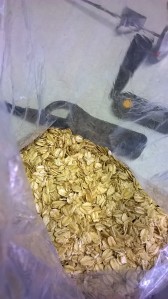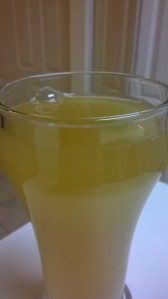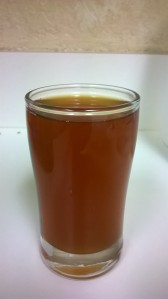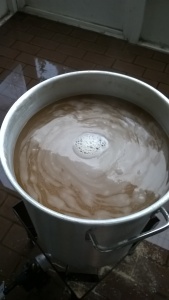Tag Archives: all grain
Fall Swing
Here’s an update on the imperial stout carbonation issue. I ended up essentially doing a pitch of US-05 into the bottles. I boiled about 100mL of water, cooled to about 70 and added about a half a satchet of yeast and let it sit for a half an hour. Then I stirred the slurry. I uncapped the bottles and added about 1mL of the slurry to each bottle and put fresh caps on and inverted the bottles a couple of times. After two weeks, my plastic bottle was firming up but didn’t get quite rock hard. I refrigerated it and opened. No head on the pour. There was a little carbonation on mouthfeel but it wasn’t anywhere near where it needed to be. So at this point, I’m just going to let it sit for the long haul and see where it’s at in a couple of months.
In other news, I’m gearing up for the holidays by brewing a lot. I have hefeweizen and my mock marzen in inventory. Bourbon porter and brown ale are in primary. And either this weekend or next, I’m brewing somewhat of a heady topper clone. I’ve bought the ingredients and it is by far the most expensive beer I’ve ever made due to the amount of hops. This is going to be a 3.5 gallon batch and it cost me about $70. A normal 5 gallon batch runs me about $40. So I have it in my mind that if this doesn’t turn out, I’m probably not going to attempt it again. This is one of those times where you aren’t saving any money by brewing it yourself. Below are a couple pics of the grobtoberfest, imperial stout and hefeweizen.
Some help here?
This is one of the rare times I ask for some class participation. My imperial stout seems to have stalled in the bottle, carbonating slightly but nowhere close to where it needs to be. I’ve inverted the bottles on two separate occasions to stir the yeast up and get it going again, but it appears my attempts have failed. Taste wise, the stout is excellent and I want to save this batch at all costs. What’s funny is when I brewed this last year, it ended up overcarbonating. Is this just a case of a fickle yeast?
This was my idea for saving it. Get a sachet of US-05, rehydrate it in warm sterile water, uncap the bottles, and add about a mL or two of the yeast suspension to each bottle, recap and invert a couple of times.
So what say you? Does this sound like a good idea? Does anybody have any other advice to give…preferably based on your actual past experiences? Thanks in advance.
Dirty Sex
I cracked open another Bloed Koning Kriek the other night in order to do a comparison between it and Boon Kriek (a commercial example) and it’s been about a month since we tasted the Bloed last. If you recall, Erika enjoyed it as did I. Well, what a difference a month makes. It has become more sour and more funky (a little barnyard). But in my opinion, it isn’t out of hand and I still enjoyed it. But what did Erika think? We’ll get to that in a bit.
Appearance: Bloed Koning was a lighter red and mostly clear while the Boon was deeper, darker red and almost opaque. Both heads after the pour were fleeting (see pics).
Aroma: Bloed Koning had light cherries on the nose along with some barnyard funk. But both were restrained. Definitely didn’t come to the level of being pungent. The Boon had no funkiness in the aroma, but was all cherries all the time. And not just cherry, but a deep sweet, almost cherry cough syrup type of smell.
Taste: Bloed Koning’s taste followed the aroma: funky, slight cherry, tart/sour, but somewhat restrained. The sour and funk had increased in the last month since we tasted it last. Boon was more on the sweeter side. No sour, no funk. Clean and fruity. Now there is a big ABV difference here. The Boon is only 4%. And while I couldn’t get a final ABV calculation do to the secondary refermentation on cherries, I’d guess the Bloed is in the 9-10% range. But the alcohol is well hidden, with no burn at all. However, you definitely could feel it in the head after sipping on it a bit.
Mouthfeel: Bloed was thinner compared to Boon but both had that effervescent carbonation. A nice prickle on the tongue.
Overall: Ok, these are two totally different animals. I’ve never had a commercial kriek before, so I wasn’t sure what to expect. From what I’ve read, some krieks are very sweet, some tend to be drier and more tart. The Boon was more on the sweet side. But what I couldn’t believe was that there was no evidence of funk anywhere in the aroma or taste for a 100% spontaneously fermented lambic. My beer tends to have more in common with Rodenbach Grand Cru, which is a Flanders Red ale that I’ve previously had. The notes in both mine and the Rodenbach are tart, funky, a touch of vinegar, a little wine like character, some earthiness. Bottom line is, Boon, for all I know, may be a fine kriek, but it wasn’t that complex. My kriek had a few more layers going on which I’m kind of happy about.
Now back to my tasting partner. I gave her samples of both. I didn’t even tell her what beers they were and just told her to taste and give me her thoughts. She thought the Boon was pretty good and that she can drink that. My beer….well…..she used the words “dirty sex throw up”. I’ll take it!!
The Busy Season
The Grobtoberfest (pictured above) has been bottled and is sitting at a nice 5.5% ABV. Taste test was clean and had a nice bready, malty flavor to it. I’m excited about this one. Solaris Hefeweizen was brewed almost two weeks ago without incident and is finishing up primary fermentation. It will be bottled this Friday. I’m getting close to doing a grain-to-glass summary for the kriek and doing a side by side tasting with a commercial kriek. So that post will be coming by the end of the month.
My imperial stout, which has been bottle conditioning for a couple weeks is being slow to carbonate. I inverted the bottles a couple times to stir up the yeast and give it a final nudge to get it past the finish line. Also, my wedding saison is finished and bottled/labeled, ready to go for the big event in less than two weeks. Lot of stuff going on, but it’s exciting. Taste wise, the imperial stout, saison and mock marzen are right on the money. After my disaster with the witbier and a subpar result with Big Mane IPA right after that (I haven’t even posted about that one), I’m getting some much needed homebrew wins here, and it feels good.
Prepping for Oktoberfest
Oktoberfest is traditionally celebrated in September in Germany but we Americans love to do it in..well…October. Maybe just because it makes more sense. My family usually gets together sometime in October to celebrate with german cuisine, german wine and german beer. We are of Swiss descent (which is pretty close to german), our last name is Grob, my father was stationed in Germany during the Vietnam war and he also has some rad, authentic, ceramic german beer steins. So when you add all of those little facts together, it is our duty to celebrate, no? However this is the first year that I’ll be making a beer, actually two, for the occasion. This past Friday, I brewed up a mock marzen and next Friday it will be a hefeweizen. I brewed Solaris Hefeweizen last year and it was spot on, though I brewed it a little too late for Oktoberfest. The marzen, also known as Oktoberfest beer, is by nature a lager. But I’m not equipped to make lagers, so I’m taking a marzen recipe and using a german ale yeast and fermenting at ale temps.
Grobtoberfest (5 gallon BIAB)
Target OG: 1.054 (based on 60% efficiency)
Target IBU: 26.3
Target SRM (color): 13.59
Target ABV: 5.42%
Fermentables:
43.4% Munich II (10L)
43.4% Vienna
8.5% Caramalt (originally was going use Dark Munich but had to substitute)
4.7% Caramunich II
Hops:
Hallertau Mittelfrau, AA 2.7% (1.3oz @ 60min, 1.3oz @ 15min, 1.4oz @ 10min)
Yeast: Wyeast German Ale 1007 (no starter, pitch per instructions)
Strike Water: 5.2 gallons @ 161F
Mash: 152F for 75 min (stirred mash every 20 min)
Strike water/grain ratio: 1.61
Sparge: 2.1 gallons @ 170F
Boil: 60 min
Brew day was a smooth as could be. I usually ferment my ales at about 68F by using a one gallon frozen water bottle next to my fermentor and switching it out twice a day. I’m going to try to push the temp down a little bit more by using 2 bottles. This will ferment for two weeks and then go into the bottles.
The ingredients, adhering to the Reinheitsgebot
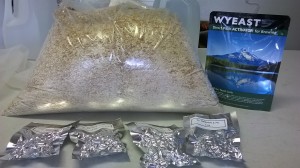
The Wort (looks dark here, but it’s really an amber color)
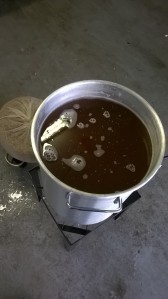
I’m hoping the end result will be a malt forward, bready, biscuity beer with a touch of that noble hop character. By the way, I picked up some of this year’s Sierra Nevada Oktoberfest lager and it is pretty solid. I highly recommend it.
Busy weekend- Saison and Imperial Stout
I had two brew days this past weekend. I brewed the wedding saison on Saturday afternoon and my imperial stout on Sunday morning. I had the house all to myself, so I took full advantage of the opportunity. When these beers are done, I’ll do full grain-to-glass summaries. The stout’s OG was 1.105, my highest ever. Both brew days went as smoothly as they could possibly go. Another piece of good news is that my kriek is carbonating nicely. I was worried that with it being in secondary for so long, that the yeast would be extremely sluggish or just inactive. I’ll crack one open at the end of August and do a full report. Honestly, I’m expecting it to taste shitty because this style is so difficult to do right and this was my first try at it. Hey, if I go in with low expectations, it’s hard to be disappointed, right?
Bloed Koning Kriek Bottling….Finally
After close to 6 months in secondary, I finally bottled the kriek this past Friday. The jury is still out on this one. Taste test indicates cherries, some funk, a bit of sourness but it’s also just plain strong. Maybe solventy, maybe vinegary. I can’t quite put my finger on what’s going on with it. Krieks are meant to be aged and will keep in the bottle for years. Along with that amount of time will be further development, so that’s why I’m reserving judgment on this one. Once I’ve achieved carbonation (based on my PET bottle tester), I’ll wait another 1-2 months before cracking one open. And I’ll probably drink one each month thereafter to follow it’s progression, if any at all. I have no idea what the final ABV is. The base beer through primary fermentation came out at about 6%. But then there was a secondary fermentation, krausen and all, when I added the cherry puree, so I don’t know how much extra alcohol was produced. I’m just guessing that it’s probably in the 10% neighborhood in total.
Because of this beer being unique and because it is designed to age, I decided I wanted to take a crack at waxing the bottles just for the coolness factor and to inhibit oxygen ingress under the cap over time. After researching what other fellow bloggers had done, I settled on using a ratio of 2.5 mini glue sticks to one regular crayon. In total, I used 20 mini glue sticks and 8 crayons of varying shades of red. I cut them up, put them in an empty and clean aluminum veggie can and placed in the oven at 400 F until pretty much melted. Then I took out, placed on a stove burner and continued to heat and stir until it was a smooth consistency. Then I just inverted a bottle, dipped straight down, then up, and gave it a slight twist when moving the bottle to the upright position. Pretty simple. However I didn’t make enough of the glue/crayon mixture to do all of the bottles. So the first ones came out great, then some were a little thin on top while the rest didn’t get done. But I was pleased at how the wax came out and know to make more next time.
The Thing About Spices
Witty Kitty Witbier is now finished and here’s the deal. The prior batch was dumped because of astringency and I had attributed it to leaving the 1oz of coriander in the wort while it fermented. So this time I separated the wort from the coriander/orange peel when transferring it to the fermentor. This yielded an improvement but there is still a slight astringency which is now showing itself more plainly as a spicy/peppery coriander overkill. It’s drinkable but could be better. So how could this be? Well to backtrack a little, when I made this beer the first two times, it was on a 2.5 gallon scale and I used 0.5 oz of coriander. Both batches came out beautifully. So just like I do with all the other ingredients when I scale a recipe up (grain, hops), I scaled up the coriander linearly. My batch was twice the size this time, so I added twice the amount of coriander. Well, apparently it doesn’t work like that, for spices anyway. Not knowing previously that this was an issue, but now seeing that it is, I googled the idea of scaling spices in homebrew linearly. Lo and behold, I got a handful of hits containing the information that spices in general do not scale linearly. So yet another lesson learned in this great hobby. So next time I’m going to play it safe by going with 0.5 oz of lightly crushed coriander and 0.75 oz of bitter orange peel.
Below is a pic of the latest witbier from my Tap-a-draft. The aroma had a mild yeasty/sulfur like smell which indicated that the 6L keg needed 3 weeks instead of 2 to condition, probably due to the higher volume compared to a bottle. I had this aroma issue in my last “good” witbier batch, and it resolved itself nicely with additional room temperature conditioning. Aside from that and the coriander issue, it looked and tasted good. I won’t have an issue drinking this batch, though it is not up to par to share with a group of people. But if someone happens to stop over, I’ll gladly pour them a glass, but with a disclaimer up front.
Big Mane IPA was bottled a week ago and will be ready for tasting next Sunday.
My next brew day is a saison for my upcoming wedding in September. But with the hectic schedule I have going on this summer, I’m struggling to fit it in. I’m hoping to get it going in the next two weeks so that, if there is a problem with the batch, I’ll have time to re-brew it if necessary. This beer will be bottled into bombers and given as parting gifts to the wedding guests.
Big Mane IPA Day
Brewed an IPA this past Friday. I’m not going to go into too much detail. I’ve brewed this before though at a 3.5 gallon scale previously. This time it’s a full 5 gallons. The recipe previously was basically 2-row, caramel 40 and all cascade hops. This time it’s essentially the same except I’m cutting back on the C40 to lighten the color and adding some carapils to give it some more body. Also at the 60 min bittering addition, I’m replacing cascade with centennial but keeping cascade for the 20 min, 10 min and dry hop additions. It’s still going to be coming out around 7% ABV and 60 IBUs. All that water on the floor in the picture below was from a Florida afternoon torrential downpour. The patio takes on some water due to poor grading. But the good news was the rain cut the air temp by about 15 degrees. Ahhhh, sweet relief!!!
Bottling of the witbier will take place this coming Sunday, hell or high water. I’m keeping my fingers crossed that it will be great.


